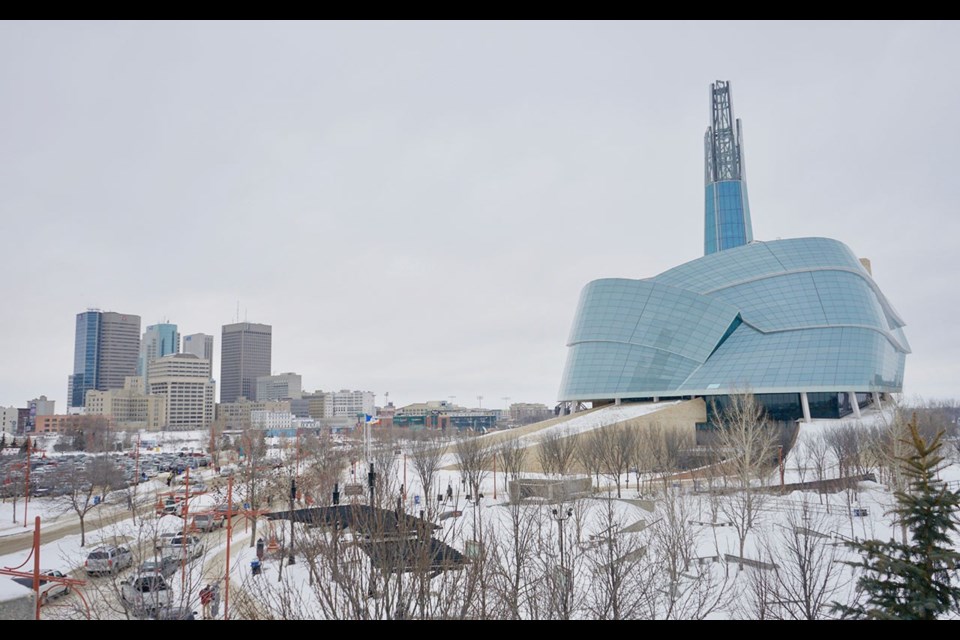As I stood in the museum gallery, contemplating photos of women, disabled people, First Nations members, workers and GLBT folks who have fought so hard for their rights, I blinked back useless tears. Since the recent American election, a museum dedicated to human rights is more relevant than ever. How quickly a hard-won right can be felled by an unjust leader.
It took me a while to visit the Canadian Museum for Human Rights. When first I heard of it, I thought if I'm a good person, that's somewhere I should want to visit. But it sounded so daunting. On my recent trip to Winnipeg, my informal poll of locals revealed that some share my ambivalence, others love to visit, a few are waiting until their kids are older, and a couple have attended weddings there. But they were unanimously proud that Winnipeg was chosen as the site of Canada's first new national museum to be created since 1967, and the only one outside the National Capital Region. Nobody said, "What museum?" Because you can't miss the Canadian Museum for Human Rights. Since its opening in 2014, the museum's massive, unusual architecture has changed Winnipeg's skyline and brought attention to an underdog among Canada's major cities.
The Architecture
From the outside, the museum looks different depending on where you stand — just like human rights. One side of the museum is all glass windows, another side is Tyndall stone, a local limestone used in many Winnipeg buildings. People have likened parts of the building's exterior to clouds, a dove, a hug.
Architect Antoine Predock designed the museum to represent a journey from darkness towards light. That direction is important, because the subject matter could easily take visitors from darkness to a pit of despair. Instead, Predock carefully considered the emotions of visitors and included space for reflection.
The building is divided into twelve galleries. The first is subterranean, as befits such weighty subject matter. Visitors ascend through the galleries by long ramps bordered by alabaster walls that let light through. The architect picked alabaster, tour guide Julie Chapko said, "because it's soft and warm, to bring comfort after a story that might have been heavy on you." Ramps were chosen instead of stairs, partly as an inclusivity statement. The 100-metre Israel Asper Tower of Hope crowns the building, affording a 360-degree view of Winnipeg.
The Exhibits
While the museum covers struggles all over the world, it emphasizes Canada's relations to human rights, for better and for worse. The Canadian Journeys Gallery is the museum's largest. Eighteen alcoves around the large round room each delve into a human rights case in Canada, including the story of Viola Desmond, who will soon grace the $10 bill. To decide which stories to include, curators travelled around Canada and asked people what they wanted to see in a human rights museum, Chapko said.
Exhibits are high-tech, incorporating audio, video, touch screens, art and huge photos of people's faces. The museum has collected more than 200 oral history interviews, dealing with subjects from the Armenian genocide to "comfort women" during World War Two. Visitors can watch mini-documentaries lasting a couple of minutes that incorporate interview excerpts. Four Canada-focused temporary exhibits will open this year to celebrate the sesquicentennial.
The blood-stained school uniform of Pakistani education activist Malala Yousafzai, on display until March, has drawn many visitors. This was the uniform she was wearing when a Taliban gunman shot her in the head on her way to school.
Controversy has shadowed the museum's mission. First Nations members dispute the museum's right to the water that comes from its taps. People have complained that the Holocaust gets too much acreage, while their own stories are told insufficiently. My guide said she was hired in large part for her customer service background; she had lots of practice at calming distressed people.
The Lesson
As we stood in the Holocaust exhibit, Chapko pointed out a photo of Auschwitz employees, arms around each other, mugging for the camera. "They didn't consider themselves murderers," she said. "They were happy to have jobs." She showed us a blueprint of the concentration camp, which included a 2,000-person gas chamber and a crematorium. Who did the architects think they were building this for, she asked? Like so many of us, they preferred not to think about the unsavoury implications of their actions.




